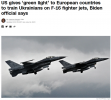Anders Nielsen, a military analyst at the Royal Danish Defense College, posted a brief analysis of the current state and prospects of the Ukrainian counteroffensive:

️The Ukrainian offensive is not going as fast as many had hoped. It may even not be going as fast as the Ukrainians themselves had hoped, but that doesn't mean they won't be able to succeed later this summer.

️The Russians are trying to re-gain the initiative in some directions, for example, by attacking in Luhansk region, but all these attacks did not lead to any significant changes in the front line. Ukraine attacks in three directions – from Orikhiv, Velyka Novosilka and Bakhmut. From Orikhiv, the most likely target is Tokmak, an important logistical hub. Although it is still far away, after a collapse of the Russian defense, things can go much faster. The re-taken area near Velyka Novosilka is also quite significant, the goal of this direction is similar to the offensive from Orikhiv – to cut off the logistics routes of the Russian Armed Forces between the Donetsk region and Crimea.

️However, the situation is different in Bakhmut – there are no powerful lines of fortifications. An offensive by the Ukrainian Armed Forces on the flanks can force the invaders to leave Bakhmut under the threat of encirclement, which will have a huge psychological effect on them, given how they trumpeted the battle for the city in their propaganda. The battle for Bakhmut is also important in that it draws Russian reserves from other directions, as well as from a psychological point of view, showing both domestic and foreign audiences the ability of the Armed Forces of Ukraine to win.

️It is impossible to exclude the crossing of the Dnieper by Ukrainian fighters. This will create huge problems for the Armed Forces of the Russian Federation, which will find it extremely difficult to fight off simultaneous attacks in the Zaporizhzhia and Kherson regions.

️Ukraine received a lot of Western military equipment for maneuver (mobile) warfare, not attrition warfare, and the West was counting on a quick breakthrough of Russian defenses. However, two serious mistakes were made:

Underestimation of the Russians – after all their previous stupidity, many in the West believed that it was only necessary to give the Armed Forces enough Western military equipment and sprinkle NATO doctrine on top, then the victory would be won by itself.

It cannot be said that NATO countries themselves are waging an exclusively maneuver warfare, and not a war of attrition. Before a maneuver war, in any case, it is necessary to weaken the enemy's defense lines – and in the West this is done by air force, gaining air superiority and destroying ground targets. When transferring military equipment to the Armed Forces of Ukraine, this part of the depletion from the air was forgotten.

️Because the Russian line of defense is too solid to break it with maneuver without attrition first, the Armed Forces of Ukraine began to use the tactics of limited advance by infantry groups with powerful counter-battery combat. But after the Russian Armed Forces have suffered enough losses, it will be possible to try again to break through their defenses by maneuver, taking into account the fact that most of the Western equipment has not yet been involved.

️In Ukraine, ground-based artillery, not fighter aircrafts, is engaged in the attrition of enemy forces. Fortunately, Western leaders have begun to better understand what a titanic task lies before the Armed Forces of Ukraine, operating with a limited number of aircrafts. And that’s where cluster munitions will be very useful – this is the only way to quickly increase the firepower of Ukraine for quick success.
The video with the full analysis can be found here:


 ️The Ukrainian offensive is not going as fast as many had hoped. It may even not be going as fast as the Ukrainians themselves had hoped, but that doesn't mean they won't be able to succeed later this summer.
️The Ukrainian offensive is not going as fast as many had hoped. It may even not be going as fast as the Ukrainians themselves had hoped, but that doesn't mean they won't be able to succeed later this summer. Underestimation of the Russians – after all their previous stupidity, many in the West believed that it was only necessary to give the Armed Forces enough Western military equipment and sprinkle NATO doctrine on top, then the victory would be won by itself.
Underestimation of the Russians – after all their previous stupidity, many in the West believed that it was only necessary to give the Armed Forces enough Western military equipment and sprinkle NATO doctrine on top, then the victory would be won by itself.  It cannot be said that NATO countries themselves are waging an exclusively maneuver warfare, and not a war of attrition. Before a maneuver war, in any case, it is necessary to weaken the enemy's defense lines – and in the West this is done by air force, gaining air superiority and destroying ground targets. When transferring military equipment to the Armed Forces of Ukraine, this part of the depletion from the air was forgotten.
It cannot be said that NATO countries themselves are waging an exclusively maneuver warfare, and not a war of attrition. Before a maneuver war, in any case, it is necessary to weaken the enemy's defense lines – and in the West this is done by air force, gaining air superiority and destroying ground targets. When transferring military equipment to the Armed Forces of Ukraine, this part of the depletion from the air was forgotten.

